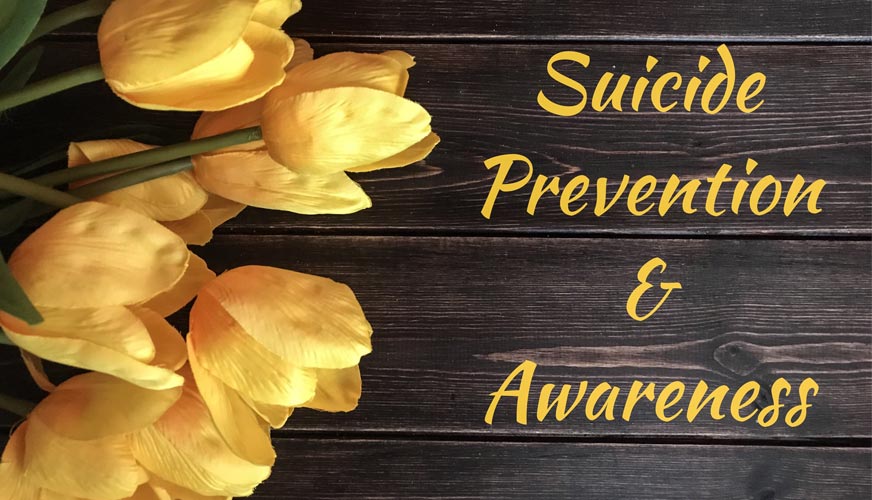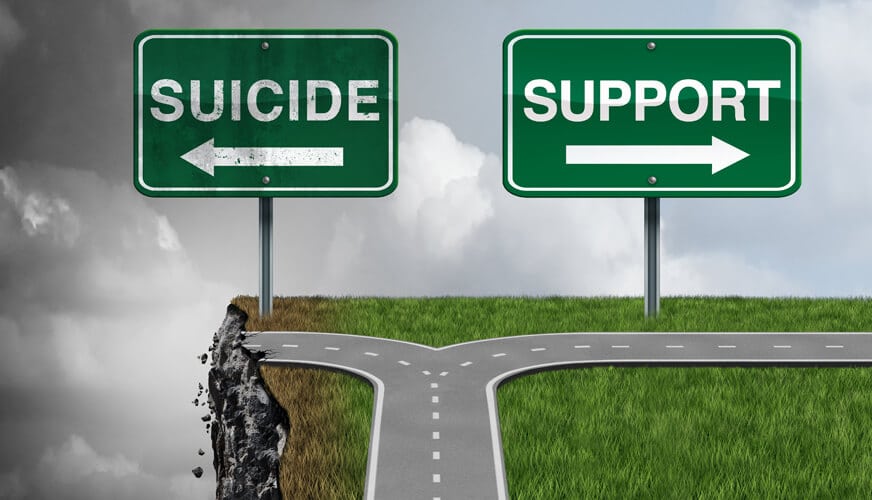University Headquarters
We Have Some of The Best Suicide Prevention and Resources
Understanding the Warning Signs, Who is Most at Risk, Prevention and Possible Treatments
Suicide is the act of intentionally taking your own life. When you attempt suicide, you are almost as likely to cause injury to yourself than to commit an act that ends in your death. Even so, suicide is the 10th most common cause of death worldwide. Men are more likely to be successful in dying via suicide, while non-fatal attempts are more likely to happen for women.
Suicide is usually something that has been considered for an extended period before the person actually tries to kill themselves. Suicidal ideation refers to thinking about dying through suicide, and is one of many factors associated with increased risk of death by suicide. Mental health issues are another common factor in suicide. However, once a person begins receiving treatment, their risk goes down sharply. Substance abuse is the next-highest risk factor after untreated mental illness.
Bullying and harassment of people in minority groups is also a factor that is known to lead to suicide attempts. This is why members of ethnic minorities and individuals who fall within the LGTBQ+ population are more likely to commit suicide.
National Suicide Prevention Hotline
1-800-273-8255
Resources for Before and After College
What are the Common Causes of Suicide?

Substance abuse, mental health issues, physical health issues, stresses around money, unemployment, relationship problems, bullying, or legal issues may make it more likely that you will commit suicide. While they aren’t necessarily risk factors, they are a stress that can either add to an existing issue or create an environment in which the concept of suicide starts to look more appealing.
The true cause of suicide is different for every person who experiences the urge. If you were emotionally, physically, or sexually abused as a child, your risk may be higher. Depression or mental health issues such as schizophrenia, bipolar disorder, or post-traumatic stress disorder (PTSD) may also mean that you are at a higher risk for suicide. Those who consider suicide have a definite goal in mind, and that is to get away from the pain and feelings they are experiencing, such as feeling victimized, rejected, lonely, guilty, or full of shame.
If someone has lost a loved one, is suffering from physical pain that doesn’t end, or is seriously ill, suicide may seem like an answer. If they are a teen, suicide may seem like an answer to whatever hardship they are going through, especially if a family member has committed suicide.
Again, the cause of suicide is always complicated and usually something that has lasted for some time. Suicide is rarely someone’s first attempt to lighten their burden or overcome the emotions they are experiencing. Because of this, many who consider suicide spend a considerable amount of time in depression before they take that last step.
Recognizing Depression

You may be feeling hopeless or as if something bad is about to happen. Depression often gets in the way of someone’s usual activities, work, and studies. Even the thought of taking on the day’s activities may be daunting for someone in the midst of a depressive episode.
To recognize depression, you need to know the most common symptoms. These are:
- Loss of interest in daily activities
They may not take pleasure in social activities, hobbies, or classes - Feeling hopeless
They feel like their situation will never improve - Sleep patterns change
They may sleep too much or develop insomnia - Changes in appetite or weight
They may lose or gain more than 5% of your body weight in just a few weeks - No energy
They may feel physically worn out or fatigued - Feelings of irritability or anger
They may feel violent or agitated with less tolerance than usual - Self-loathing
They may feel guilty about something and criticize themselves constantly - Can’t concentrate
Making decisions or focusing are both difficult - Behaving recklessly
They may drive too fast, abuse substances, or gamble compulsively - Aches or pains
They may feel more physical pain, such as back, stomach, headaches, or muscle aches
Higher Risk Student Populations
LGTBQ+
LGTBQ+ youth deal with a lot of struggles, from both inside and outside sources. With these increased stresses, they may develop mental health issues more often than heterosexual youth. Non-randomized surveys taken by youth who identify as bisexual, gay, or lesbian shows that close to one-third say they have attempted suicide at least one time. This is higher than for other individuals.
LGTBQ+ youth appear to be at a higher risk of suicide than other youth – this is usually considered to be due to environmental factors such as rejection by family members, sexual bias, or bullying. As LGTBQ+ youth experience these stressors, they may respond with anxiety and depression, which leads to attempts to reduce their stress including incidents of self-harm, such as cutting.
Youth in the LGTBQ+ population also experience much more suicidal thinking than heterosexual youth. As an example, reports of suicidal ideation are twice as likely to happen among LGTBQ+ youth.
Here are some resources that exist specifically to help LGBTQ+ youth:
- The Family Acceptance Project
- Trans Lifeline
- The Trevor Project
- Suicide Prevention Among LGBT Youth: A Workshop for Professionals Who Serve Youth
- The LGBT Aging Project
- Greater Boston PFLAG
- LGTBQ Support/BrAGLY
- Massachusetts Department of Public Health’s Safe Spaces for LGTBQ Youth Program
- “Saving Our Lives” (Skill-building video)
Minorities
While suicide rates among Hispanic youth are lower than they are among the US population overall, there is one state in which they rank second in the nation. In Texas, the female Hispanic population is more likely to commit suicide, at almost twice the rate of non-Hispanics (teens and young adults). One out of every seven Hispanic females in the US will attempt to commit suicide. This may be due to struggles with getting healthcare access, cultural differences, language barriers, poverty, or unhealthy family dynamics.
Black youth between 10 and 19 lead in deaths from suicide. More than 3,000 youth committed suicide in 2017. In 2007, the rate was 2.55 per 100,000; in 2017, it was 4.82. One cause may be that black youth are likely to internalize the issues surrounding racism in the US. Another reason may be lack of coping skills and limited access to mental healthcare. However, for both these groups, the same pressures apply to them that apply to other youth. Meaning these other issues are added to an already long list of pressures that the youth of today face.
Here are some resources meant specifically for these at-risk groups:
- National Suicide Prevention Lifeline: 1-800-273-8255
- National Alliance on Mental Illness: Compartiendo Esperanza
- Indian Health Service: How to Talk About Suicide
- Suicide Prevention in Indian Country
- Rising Sun Toolkit: Support suicide prevention efforts among Arctic indigenous communities
- Suicide Prevention Resource Center American Indian/Alaska Native Settings portal
- Suicide Safe: Prevention app
- Each Mind Matters: California Mental Health Movement
Veterans
Between 2008 and 2016, more than 6,000 veterans committed suicide annually. The suicide rate for veterans went up by 25.9% between 2005 and 2016 but between 2015 and 2016 their suicide rates fell from 30.5 per 100,000 to 30.1 per 100,000.
Statistics for 2016 show that veterans who were using healthcare services from the Veterans Health Administration experienced higher suicidal rates than those veterans who didn’t use the VHA. The veterans who were seeking assistance did so because their physical and mental health conditions caused significant issues in their lives. These included substance abuse, mental health issues, chronic pain, and chronic medical conditions.
Female veterans saw their suicide rates increase during this same period. Comparing female veterans and non-veteran females, the suicide rate is higher for female veterans. This fell between 2015 and 2016, but the difference was too small to be significant.
Here is a list of resources for veterans:
- Together We Can: Suicide Prevention Information for Veterans, Their Families, and Caregivers - This is a series providing comprehensive information for veterans, caregivers, and family members.
- Coaching into Care: 1-888-8223-7458
- Make the Connection (dot) net: Veterans record their descriptions of dealing with suicidal ideation, then describe what they did to get into recovery
- Suicide Prevention: A Guide for Military and Veteran Families
Stigma Surrounding Depression and Suicide
Friends and family of those who have committed suicide often feel shame and stigma about their loved one’s death. As an example, when Kate Spade committed suicide, entertainment media outlets began to publicly speculate about what led to her death and what her motives were. Her husband and sister said that Spade suffered from depression, bipolar disorder, and anxiety. While this information was deliberately made public, other aspects of Spade’s life were kept private.
Seeing the immediate reaction of media outlets and the general public is a good look into how the public fails to respect the deceased person, especially if they suffered from a mental health disorder. And this cautions others who have a mental illness or disorder that they shouldn’t be too open about it, or they may be perceived poorly or thought of as being at risk of suicide, even if they aren’t.
Suicide is stigmatized by those who have never experienced a suicide; they may shun people who are grieving or stereotype suicide as being purely cause by mental instability, though some people commit suicide because of outside influences that make their life seem like it’s not worth living or heap shame on them for their decisions or feelings. Suicide used to be a crime in many countries, increasing this stigma. People put suicide on par with homicide; even the name of the act suggests it is a “self-murder”. Mental health professionals are working to remove the stigma surrounding thoughts of and even attempts at suicide. Stigmatizing either the reason for it, or the act itself, helps no one.
Risk Factors for Depression or Suicide
What are risk factors for suicide? These are the conditions in your life that may increase the possibility of you trying to take your life. If you know someone who died by suicide, you may know if they suffered from mental or physical health issue; they may have been dealing with discrimination because of their minority or sexual identity status; or they may have been struggling with poverty and hopelessness, feeling as though nothing they did would change the situation. Someone may be struggling with substance abuse issues or they may suffer from anxiety.
Environmental factors that increase the chance of suicide may include harassment, relationship issues, or bullying. Stressful events, such as divorce or another loss may also contribute. They may have been exposed to someone else’s suicide or to graphic accounts of the person’s death. A family history or individual history of suicide are also risk factors, or the person may have suffered abuse or neglect. If you or someone else is depressed, an assessment can tell you if your depression is a risk factor.
Common Risk Factors
- Prior attempts at suicide
- Mental health issues
- Substance abuse issues
- Social isolation
- Access to tools of suicide
- Lack of access to mental healthcare
- Chronic disease/disability
- Historical trauma suffered by minority groups
- Stress coming from discrimination
- Loss, such as unemployment or divorce
- Chronic pain
- Sleeping issues
- Financial issues
- Exposure to suicide
Warning Signs for Suicide

Warning signs of an imminent risk of suicide are different from risk factors. Risk factors point out that someone is at a higher risk for suicide, not whether or not they are in an immediate crisis. But warning signs let you know you should be careful. They say, “Watch out. This person is in crisis and actively thinking of suicide.” People in the middle of a suicidal crisis tend to follow some basic patterns that you may be able to notice. However, it’s important to remember that this isn’t always the case. Some people hide their intentions very well.
You may have observed that a person has several risk factors that are making their life harder than it should be. They may have experienced a major loss or developed a serious illness. There may be a history of suicide, either in the family or attempts by the person. Knowing this, you may be spending more time with this person or at least, keeping a closer eye on their actions and moods. If they have a mental health disorder, you may need to be even more observant.
What are the Common Warning Signs:
- Seem more peaceful
- Loss of interest in things they previously enjoyed or life itself
- Depression
- Rage
- Impulsiveness
- Irritability
- Anxiety
- Humiliation
- Despair
Talk—Expressing the following verbally:
- Poor problem-solving ability
- Feeling like a burden
- “No reason to live”
- Talk of feeling trapped
- Expresses “unbearable pain” (emotional)
- Feels helpless and hopeless
Behavior—Common behavior signs:
- Hopeless about the future
- Uses more alcohol or drugs
- Gives prized belongings away
- Obtains lethal means to suicide
- Calls or visits people to say “goodbye”
- Acts recklessly
- Sleeps too much/too little
- Withdraws from formerly enjoyable activities
- Isolates self from family/friends
Protective Factors for Suicide
Along with risk factors that increase the possibility that someone may try to kill themselves, there are protective factors that lower those chances as well. These factors aren’t as well-known because they haven’t been explored as extensively. And, if society, families, friends, and mental health professionals are going to help people considering suicide, they need to know what factors may protect them.
Some are as simple as having positive support from family, friends, and clinicians. Others are more complex. One of these is religious beliefs that can lead people away from suicide as an answer. Historical and cultural factors may also help people to reach out and ask for help from others of the same culture.
Protective Factors:
- Cultural/religious beliefs - encourage self-preservation
- Support from family, friends, and the community
- Good clinical care to address mental or substance abuse disorders and physical issues
- Community access to clinical help
- Availability of support and intervention from medical and mental health professionals
- Developing skills in:
- Conflict resolution
- Problem solving
- Resolving disputes without violence
- Ongoing contact with caregivers
- Good coping skills
Possible Suicide Treatment Options for Students

Treatment includes everything that helps someone who is thinking of suicide to begin to move away from their darker thoughts. Along with therapy, they are taught new coping skills and, if needed, they may be prescribed medication. These give them additional protective factors that draw them away from suicidal behaviors. After all, most forms of depression have at least some physical component.
Training programs for those who are experiencing suicidal thoughts work from the belief that suicidal behavior stems from feeling hopeless. As this happens, the person is literally unable to find or use effective strategies in dealing with stressful events. Therefore, good programs include social-emotional earning, along with addressing family relationship issues and parenting skills. A social-emotional program should teach clients to develop and strengthen both their problem-solving and communication skills. They should also learn how to regulate their emotions, seek out help, and attain new coping skills. In teaching all of these new skills, risk factors are addressed and decreased and protective factors are strengthened, which lowers the risk of suicidal behaviors or ideation.
Where to Look for Treatment
Students struggling with suicidal thinking need to know where they can go when they are struggling with their thoughts and feelings. Most, if not all, university campuses have a student counseling center or mental health clinic. If students decide to seek help, they can call the counseling center and request help from a licensed mental health counselor or therapist. Rather than numbing their pain with alcohol or drugs, cutting, or unhealthy eating, students can begin to see a counselor to discuss what has led them to consider suicide.
Their friends may realize something is wrong and urge them to seek help. This may be enough for someone to retake control over their life and their emotions. However, sometimes, it takes a suicide attempt, an overdose, or a near-lethal cutting episode for them to be referred for mental health counseling.
Once they have received a mental health diagnosis, they can begin receiving the most appropriate form of treatment. They will also begin learning new, healthier habits and coping skills. Their therapists may suggest they resume a favorite craft or hobby, and generally help them to find a healthier focus.
Suggestions on Finding Help:
- Address cutting habits via mental health intervention
- See a clinician for suicidal ideations
- Make healthy changes to your lifestyle
- Exercise at least three days/week
- Find a spiritual outlet or advisor
- Build a good support network and make sure they know what you’re dealing with
- Schedule an outing or dinner with a friend who you trust once a week
- Develop better coping skills (emotional regulation, problem-solving, addressing relationship issues in a healthy way)
Action to Help Others
If you see a friend in the dorms or on campus who tells you they are “thinking of ending everything”, pay attention to them! They may be deep in a suicidal crisis and they need help. Ask them to explain just what they are saying so you are able to acknowledge their feelings and thoughts. Above all, you want them to know that you hear them. And, if they do express a wish to die via suicide, they may have done so because they trust you with this revelation.
Try not to give advice. Instead, offer them your unconditional support for their feelings but make certain they know that you don’t think suicide is the only answer. You don’t have to handle it alone. Without violating your friend’s confidence, talk to someone else.
You may notice that someone seems different from how they usually appear. Speak up, express what you’ve noticed. Let them know you’re there for them and ask how you can help.
List of Resources on Helping a Friend or Family Member:
- Student Counseling Center or Mental Health Center on campus
- Call 911 if your friend/family member has already attempted suicide
- Contact your dorm resident assistant (RA) or spiritual leader if suicide isn’t imminent
- American Association of Suicidology (1-800-273-8255)
More Resources:
- American Foundation for Suicide Prevention
Helps to connect people from different communities to understand and prevent suicide. The organization also works to help heal the pain of suicide. - Half of Us
This organization knows mental health issues affect a large part of the population, particularly young people. The organization’s title stems from knowing half of our students admit that stress immobilized them. - IMAlive
Online crisis network with 100% of the volunteers trained and certified for crisis interventions. - National Center for Injury Prevention and Control
This arm of CDC helps to protect people from both injury and violence. It researches how to prevent violence and injuries. - Suicide Prevention Resource Center
Federally supported resource that advances the work of the National Strategy for Suicide Prevention - The Jed Foundation
Promotes emotional health to prevent suicide in the college population. - ULifeline
An online resource addressing mental health for college students. A help line for students with serious mental health issues (suicidal thoughts) and how to help.
Final Thoughts
Finding out that a friend or family member is thinking of dying via suicide is frightening. You’ll want to try to reduce the risk to your loved one if you believe an attempt is imminent. You should try to remove the means of committing suicide (weapons, pills).
Even if they aren’t in immediate danger, try not to leave them alone. Listen, be supportive, and encourage them to get professional help. When you are with them, make sure you listen more than you speak. When you do speak, make it directly from your heart. Be open to their feelings and don’t judge them. This may get through to them.
National Suicide Prevention Lifeline
Sources:
- https://youth.gov/youth-topics/lgbtq-youth/health-depression-and-suicide
- https://www.mass.gov/info-details/suicide-prevention-lesbian-gay-bisexual-and-transgender-lgbt
- https://www.cdc.gov/nchs/data/hestat/suicide/rates_1999_2014.htm
- https://www.mentalhealth.va.gov/suicide_prevention/resources.asp
- https://afsp.org/risk-factors-protective-factors-and-warning-signs
